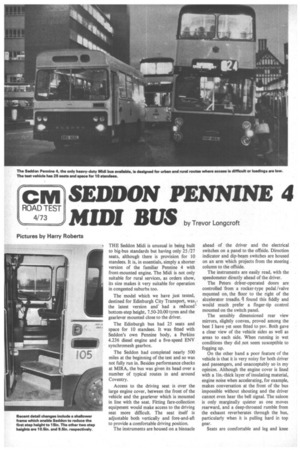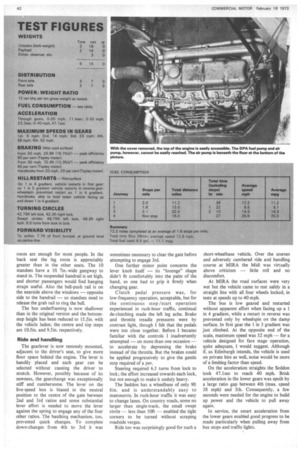SEDDON PENNINE 4 MIDI BUS by Trevor
Page 42

Page 44

Page 45

If you've noticed an error in this article please click here to report it so we can fix it.
THE Seddon Midi is unusual in being built to big-bus standards but having only 25/27 seats, although there is provision for 10 standees. It is, in essentials, simply a shorter version of the familiar Pennine 4 with front-mounted engine. The Midi is not only suitable for rural services, as orders show, its size makes it very suitable for operation in congested suburbs too.
The 'model which we have just tested, destined for Edinburgh City Transport, wasi‘ the latest version and' had a reduced' bottom-step height, 7.50-20.00 tyres and the gearlever mounted close to the driver.
The Edinburgh bus had 25 seats and space for 10 standees. It was fitted with Seddon's own Pennine body, a Perkins 4.236 diesel engine and a five-speed ENV synchromesh gearbox.
The Seddon had completed nearly 500 miles at the beginning of the test and so was not fully run in. Besides performance checks at MIRA, the bus was given its head over a number of typical routes in and around Coventry.
Access to the driving seat is over the large engine cover, between the front of the vehicle and the gearlever which is mounted in line with the seat. Fitting fare-collection equipment would make access to the driving seat more difficult. The seat itself is adjustable both vertically and fore-and-aft to provide a comfortable driving position.
The instruments are housed on a binnacle ahead of the driver and the electrical switches on a panel to the offside. Direction indicator and dip-beam switches are housed on an arm which projects from the steering column to the offside.
The instruments are easily read, with the speedometer directly ahead of the driver.
The Peters driver-operated doors are controlled from a rocker-type pedal/valve rnquated on, the floor to the right of the accelerator treadle. 1 found this fiddly and would much prefer a finger-tip control mounted on the switch panel.
The sensibly dimensioned rear view mirrors, slightly convex, proved among the best I have yet seen fitted to psv. Both gave a clear view of the vehicle sides as well as areas to each side. When running in wet conditions they did not seem susceptible to fogging up.
On the other hand a poor feature of the vehicle is that it is very noisy for both driver and passengers, and unacceptably so in my opinion. Although the engine cover is lined with a lin.-thick layer of insulating material, engine noise when accelerating, for example, makes conversation at the front of the bus impossible without shouting and the driver cannot even hear the bell signal. The saloon is only marginally quieter as one moves rearward, and a deep-throated rumble from the exhaust reverberates through the bus, particularly when it is pulling hard in top gear.
Seats are comfortable and leg and knee room are enough for most people. In the back seat the leg room is appreciably greater than in the other seats. The 10 standees have a 1ft 7in.-wide gangway to stand in. The suspended handrail is set high, and shorter passengers would find hanging straps useful. Also the bell-push rail is on the nearside above the windows — opposite side to the handrail — so standees need to release the grab rail to ring the bell.
The bus underframing is now shallower than in the original version and the bottomstep height has been reduced to 15.5in. with the vehicle laden; the centre and top steps are 10.5m. and 9.5in. respectively.
Ride and handling
The gearlever is now remotely mounted, adjacent to the driver's seat, to give more floor space behind the engine. The lever is handily placed and each gear can he selected without causing the driver to stretch. However, possibly because of its newness, the gearchange was exceptionally stiff and cumbersome. The lever on the five-speed box is biased in the neutral position to the centre of the gate between 2nd and 3rd ratios and some substantial lever effort is needed to move the lever against the spring to engage any of the four other ratios. The baulking mechanism, too, prevented quick changes. To complete down-changes from 4th to 3rd it was 'sometimes necessary to clear the gate before attempting to engage 3rd.
One further minor point concerns the lever knob itself — its "lozenge" shape didn't fit comfortably into the palm of the hand, so one had to grip it firmly when changing gear.
Clutch pedal pressure was, for low-frequency operation, acceptable, but for the contintous stop /start operation experienced in rush-hour traffic, continual de-clutching made the left leg ache. Brake and throttle treadle pressures were by contrast light, though I felt that the pedals were too close together. Before I became familiar with the controls I inadvertently attempted — on more than one occasion — to accelerate by depressing the brake instead of the throttle. But the brakes could be applied progressively to give the gentle stop required of a psv.
Steering required 6.5 turns from lock to lock; the effort increased towards each lock, but not enough to make it unduly heavy.
The Seddon has a wheelbase of only 9ft 6in. and is understandably easy to manoeuvre. In rush-hour traffic it was easy to change lanes. On country roads, some no larger than single-track, the small swept circle — less than 50ft — enabled the tight corners to be turned without scraping roadside verges.
Ride too was surprisingly good for such a short-wheelbase vehicle. Over the uneven and adversely cambered ride and handling course at MIRA the Midi was virtually above criticism — little roll and no discomfort.
At MIRA the road surfaces were very wet but the vehicle came to rest safely in a straight line with all four wheels locked, in tests at speeds up to 40 mph.
The bus is low geared and restarted without apparent effort when facing up a 1 in 4 gradient, while a restart in reverse was prevented only by wheelspin on the damp surface. In first gear the 1 in 3 gradient was just climbed. At the opposite end of the scale, maximum speed was 52 mph — for a vehicle designed for fare stage operation, quite adequate, I would suggest. Although if, as Edinburgh intends, the vehicle is used on private hire as well, noise would be more of a limiting factor than speed.
On the acceleration straights the Seddon took 47.1sec to reach 40 mph. Brisk acceleration in the lower gears was spoilt by a large ratio gap between 4th (max. speed 38 mph) and 5th. Consequently, a few seconds were needed for the engine to build up power and the vehicle to pull away again.
In service, the smart acceleration from the lower gears enabled good progress to be made particularly when pulling away from bus stops and traffic lights. Fuel consumption figures were taken over a mixture of typical routes. The first run was over narrow hilly roads in a rural area with little other traffic in evidence. The second route — a complete contrast — took in Coventry city centre in the evening rush hour. Some idea of the traffic congestion met, is gained when one considers that it took lhr 22min to cover 13 miles. The Midi was queueing in traffic for much of the time and consequently fuel consumption suffered because of the cons, sit stop /start operation.
The third route involved both town and rural operation outside rush hour. Stops for traffic lights and other hold-ups were rare compared to the previous run, the fuel consumption benefiting as a result. The final run was non-stop high speed and the good fuel consumption obtained indicates the detrimental effects of continual stop /start operation.
Plus and minus
Summarizing: the vehicle's plus points manoeuvrability, but does not detract from stability.
are good ride, liveliness and manoeuvrability allied with an acceptable fuel consumption. On the minus side the vehicle is far too noisy internally, and needs attention here, especially if the coach version currently being developed is to gain general operator acceptance. Even accepting that a bus is not expected to meet the same standards as a luxury coach, finish and final design showed some aggravating deficiences. For instance although our test vehicle had completed only about 500 miles, the door required adjustment before it would operate correctly, and two of the three saloon lights refused to work. Further, the engine inspection cover was secured with no fewer than 14 bolts. On re-assembly two bolts did not line up with their appropriate captive nuts.
But basically the Midi is a sturdy and practical vehicle, not a boy being asked to do a man's work, which is often the case with small buses. In the form tested it costs £5,577.












































































































